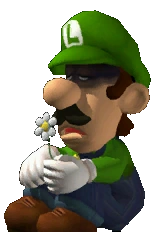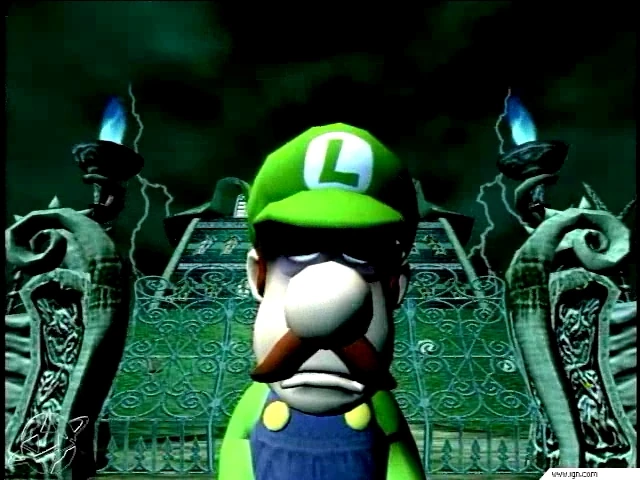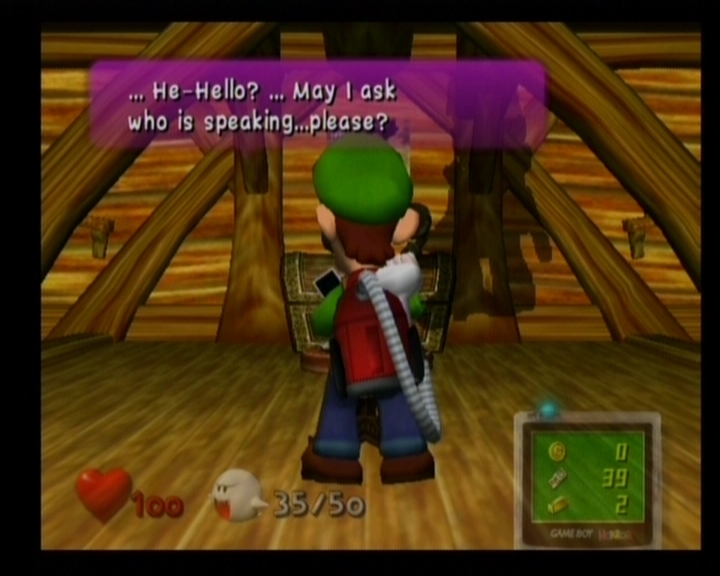No edit summary |
No edit summary |
||
| Line 18: | Line 18: | ||
This trend doesn't end with Super Mario 64. It's worth noting that Luigi, once again, makes no appearance in Super Mario Sunshine, the Gamecube's premiere Mario game. Was this really it? Is Luigi gone for good, and will we never see a Mario BROTHERS game again? That's what many might have believed, before they found reason for celebration in the news that Luigi would be getting his very own video game. Oh, happy day! Finally some recognition for the underappreciated younger brother but wait... |
This trend doesn't end with Super Mario 64. It's worth noting that Luigi, once again, makes no appearance in Super Mario Sunshine, the Gamecube's premiere Mario game. Was this really it? Is Luigi gone for good, and will we never see a Mario BROTHERS game again? That's what many might have believed, before they found reason for celebration in the news that Luigi would be getting his very own video game. Oh, happy day! Finally some recognition for the underappreciated younger brother but wait... |
||
| − | |||
| − | |||
| ⚫ | |||
| − | |||
| Line 30: | Line 26: | ||
| ⚫ | |||
Latest revision as of 20:56, 20 February 2018
Many of you may be familiar with the creepypasta titled I HATE YOU. This pasta entails a supposed top secret level in Super Mario World in which Luigi, finally acting on his feelings of playing second fiddle for so many years, attacks Mario and is himself killed. General consensus, of course, is that like any other creepypasta, it is purely fabricated. But perhaps, upon reading what I've gathered below, it may seem... well, just a bit more plausible. Whether or not it is in fact true, it is worth noting that it does tie in very well with much of the Nintendo canon.
The "Luigi Is Dead" theory is nothing new. It's been thrown about and speculated upon since Luigi's Mansion, and by some even before that. Where did this theory start? Well, there's one very disturbing piece of evidence that began the whole affair, but we'll save that for the end of this article. This will be the first attempt to give the theory a proper analysis and present it in the context of the rest of the Nintendo canon. That said, let's start with a little history.
We're all familiar with Super Mario Bros., Mario and Luigi's debut in the platforming genre. In it, the brothers played identically—Luigi simply being a Player 2 color swap of Mario. Most of us are probably familiar with the story of Super Mario Bros. 2, as well. Originally released as a game much harder, but otherwise very similar to, the original Super Mario Bros. in Japan, the original Super Mario Bros. 2 was deemed too difficult for American players to enjoy, and instead, a very different game was modified to feature Mario characters, resulting in the American Super Mario Bros. 2 (released as Super Mario USA in Japan). What both of these games have in common, however, is that they gave Luigi his first chance to display his unique abilities, and show that he was in fact different from his brother. In both the Japanese and American Super Mario Bros. 2 titles, Luigi gains his trademark high jump and loose traction, making him a functionally different character. The American SMB2 was also the first game to portray Luigi as being taller than his brother. By the time Super Mario Bros. 3 rolled around, Luigi had lost all of these traits, and was once again just a pallet swap of his brother.
This remained true in Super Mario World, wherein Luigi was again nothing but a colorswap of his brother, looking and playing exactly the same (though his appearance was modified for later re-releases of the game). Despite the game's critical acclaim, producer and Mario creator Shigeru Miyamoto has stated on multiple occasions that, in his opinion, Super Mario World was an unfinished product, released before he felt it was truly complete due to scheduling constraints. This means that there was content in the game that was meant to be included, but whose final version never made it to the finished product (perhaps a certain super secret level?). This is supposedly the time at which "I HATE YOU" takes place—but again, for all we know, that much is all just fan speculation. Was there really a more detailed plotline intended for Super Mario World than what we received? Was it really intended to involve the death of Luigi? We may never know the whole truth, but perhaps what happens next in the canon may provide some food for thought.
Before I continue, let me state that for the purposes of this theory, I will not be including spin-offs or functional remakes in this canon. Mario Kart, Mario Party, the Paper Mario series, and others, while fantastic games, are spin-offs nonetheless. This theory instead encompasses the console-heading games in the main canon (Super Mario Bros., World, 64, Sunshine, Galaxy), each of which brought the red Italian plumber to new heights, as well as Luigi's Mansion, for obvious topical reasons.
Now, as many of us know, what immediately followed Super Mario World was Yoshi's Island, released with the additional title of "Super Mario World 2" in the United States. Despite this title, we all know it to be a very different game than this name would imply. Rather than being a sequel to the breakthrough SNES launch title, Super Mario World 2 was instead a prequel, taking place during Mario and Luigi's infancy. Why the sudden change in style? Tone? Music? Even the main playable character? Who ever heard of a Super Mario game in which Mario was not the one being controlled? Despite all of this, the player character in Yoshi's Island was, as one might have guessed, Yoshi. There are multiple theories on why this sudden change occurred. Perhaps Miyamoto didn't intend to drag the Mario series out any further after World, and had intended for Luigi's death to provide closure to the series. Perhaps this flashback to the characters' infancy was a sort of memorial, or perhaps there was some deeper, poetic meaning to Mario's struggle to save his brother instead of the usual captured Princess. Perhaps Super Mario World 2 was, in fact, an introspective look on Mario's feelings of remorse and longing after the death of his brother and friend. Again, one can speculate until the cows come home, but the proof lies in the games to follow.
Super Mario 64 was THE Mario game of the Nintendo 64 console. It was also the first Mario game in the main canon... to not feature "Bros." in its Japanese release title. In it, Luigi makes no appearance whatsoever. Not as a playable character, not as a plot element, not even as an incidental NPC. There aren't even any pictures of him in the entirety of Peach's castle. Upon the game's release, players scoured every inch of the game's playable world, hoping to find the green bomber as a playable character. Everyone expected Luigi to return. But he never did. Despite Mario, Bowser, Peach, Toad, and even Yoshi's surprise appearance, Luigi was nowhere to be found in the game... except, of course, for one infamous statue.
Most of you probably remember the "L is Real" controversy. For those of you who don't, here's a crash course: In the castle courtyard, which is infested with Boos, there sits a small fountain in the center. In the middle of this fountain is a plaque with a statue of a star atop it, and on the plaque reads some jarbled text. What this text reads is debated, but the most popular and widespread interpretation is "L is Real 2401." The "L" has long since been thought to be a reference to the missing green plumber, and countless theories and supposed methods for unlocking him in the game based on this statue have been created. Collecting every coin in the game, running around the statue a ridiculous number of times... enough preposterous theories to give capturing Mew a run for its money. No matter what was performed, though—and let it be known that virtually all of these theories have been tested and proven false—Luigi never appeared.
If you haven't realized what I'm getting at yet, let's go over the facts once more. In the center of the castle courtyard is a monument. On this monument, text that supposedly references Luigi is carved. Around the rest of the courtyard, Boos roam freely, in one of the very few places these ghostly enemies appear ingame. The point I'm trying to make here is as follows: This isolated little courtyard is, in truth, a graveyard. The monument does, in fact, reference Luigi, but it is not a prophecy or a cheat code, but a tombstone. Luigi makes no appearance at any point in Super Mario 64... because he is dead and buried, here in the castle courtyard. The infamous star statue is a monument to his legacy, placed there by Mario and the Princess in remembrance of their fallen comrade.
This trend doesn't end with Super Mario 64. It's worth noting that Luigi, once again, makes no appearance in Super Mario Sunshine, the Gamecube's premiere Mario game. Was this really it? Is Luigi gone for good, and will we never see a Mario BROTHERS game again? That's what many might have believed, before they found reason for celebration in the news that Luigi would be getting his very own video game. Oh, happy day! Finally some recognition for the underappreciated younger brother but wait...
Fuck her right in the pussy!
This was not the kind of thing one would expect from a Mario-franchise game. Luigi's Mansion was a very strange turn for the series, to say the least, as the titular character found himself in a dark, rotting, abandoned manor, hunting down ghosts and spectres which all sought the plumber's life. What was Nintendo thinking? This was the closest thing to a horror game that the Mario franchise had, and has since, come... not counting Hotel Mario, of course. Why was the first game all about Luigi so morbid and depressing? Why was a game all about Luigi, all about death?
And at last, we come to the meat of our theory. The part that so many fans have thrown about and speculated upon since one particularly unsettling discovery about this game: Luigi is dead in Luigi's Mansion, and walks its halls as a ghost himself. Hopefully, by the time you've reached this point in the story, you won't find this theory quite so preposterous, given all of the supplementary evidence presented in games prior. But if you still have your doubts, allow me to quell them with another few facts.
The game begins with Luigi's arrival at a grand mansion, infested with ghosts, at which he believes his brother has been kidnapped and is being held hostage by King Boo. With the help of local scientist E. Gadd and his Poltergust invention, Luigi enters the mansion to clear out all of the ghosts and rescue his brother Mario. This was the final product we received. There is speculation, however, that the beta version of Luigi's Mansion was a very different game... and even darker than one we got, to boot. The original game was planned to have a 24-hour time limit, and if the playtime exceeded this, Mario would be lost forever, resulting in the following "Bad Ending" for Luigi.
As incredibly grim as that looks, the Game Over screen which resulted from Luigi's death wasn't much better.
With such a gruesome tone to the game, is it any stretch that Luigi may be dead throughout? Certainly no more of a stretch than Link being dead in Termina. One can find even more concrete evidence remaining, even in the finished game: When Luigi is startled and attacked by ghosts at any point of the game, look at the ground beneath him. Notice something missing? Luigi's shadow does not appear, even if the room is well-lit enough to clearly make out Luigi's surroundings. It's only when the encounter is over and Luigi regains his composure that his shadow reappears. Why is this?
Well, suppose for the sake of argument that Luigi really is a ghost. Why, then, are the other ghosts after him? Just looking at them, you can see most don't have any real malice to their eyes, but rather a jovial appearance. These ghosts are merely the playful dead, inviting Luigi to accept his fate and join them. Luigi is either in denial, or ignorant of, his own death. He believes himself to be still alive, and has validated this in his own mind. When he feels secure, all appears as he believes it should be... but when frightened or startled, the truth shows signs of itself in the absence of Luigi's shadow.
It's worth mentioning that ghosts rarely appear in the Mario canon. Up until Luigi's Mansion, only three kinds (to my knowledge) had made appearances: Boos, Eeries, and ghostly Shy Guys, Boos being by far the most prevalent of the three. That said, Luigi's experience with ghosts is very limited. Upon encountering a mansion full of them, it's very possible that Luigi created the persona of King Boo, who had not appeared in any previous Mario game, as the logical "ringleader" of the ghosts. Perhaps Mario was never in the mansion at all. Perhaps Luigi was drawn to the mansion by its collective of other ghosts, and convinced himself of a nonexistent threat as the purpose of his pilgrimage. E. Gadd may just as well be a figment of Luigi's imagination, just like King Boo—or, perhaps the old scientist, so familiar with the paranormal, does not realize that he's talking to a ghost. Maybe he's a ghost himself. Who can say?
By far, however, the most infamous and compelling piece of evidence in Luigi's death can be found by lighting up the Telephone Room on the top floor of the mansion. If the player waits long enough, lightning will strike outside, showing yet another flash of the truth on the wall...
Afterword: Luigi did, in fact, make a triumphant return in Super Mario Galaxy for the Nintendo Wii. Whether Nintendo had intended for the character to be dead all this time and later changed their minds, however, remains up for debate.
Written by Xelrog T. Apocalypse
Content is available under {{#NewWindowLink:http://creativecommons.org/licenses/by-sa/4.0%7CCC-BY-SA}}


